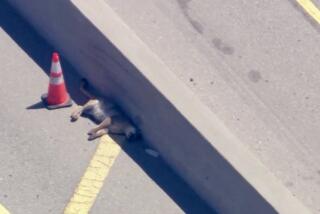THE NATION - News from April 26, 2009
- Share via
NEW HAVEN, VT. — The black salamander with yellow spots sat on the roadside in the dark, ready to make a go of it.
But it was not on its own. It got help from an escort -- one of 45 people who volunteered on a recent night to carry salamanders, frogs and newts across the road during their annual migration to mate.
On rainy nights in early spring, roads between forests and vernal pools are hopping and crawling with activity. On some nights, hundreds of amphibians cross small stretches of asphalt to mate. But many don’t make it.
From rural Vermont to urban centers like Philadelphia, human escorts, called bucket brigades in some places, help amphibians make it to their mating areas without getting squashed by cars. It’s part education, part conservation and part science.
“It’s an extraordinary thing and people deserve to know about it,” said Warren King, a member of the Otter Creek Audubon Society, who organizes a crossing in Salisbury, Vt. “And it needs to be protected. There are sites where many of the critters that are crossing never make it.”
On a recent night, University of Vermont student Kaitlin Friedman walked with other volunteers along the asphalt with flashlights and clipboards, moving wood frogs, peepers, blue-spotted, red-backed and four-toed salamanders across the road, while jotting down how many they saw.
They also kept count of vehicles, and the amphibians that didn’t make it, doing their best to identify the flattened carcasses.
“It’s pretty much the one time of year where you get to see a lot of salamanders in abundance, and it’s just really cool,” said Friedman, 20, of Long Island, N.Y. “Plus, you know you help them across the road, you feel like maybe you’re making a small reduction in their mortality rates, maybe, just for that hour or so.”
John Kart of Richmond, Vt., and his family have been helping salamanders cross the road for five years. On a recent evening, he said his 5-year-old daughter and two friends were as excited as the salamanders as they peered into a watery ditch.
“We’re a little early this year, but often you come and it is just loud as all get out from all the peepers and wood frogs screaming down in the pond below,” he said.
The half-dozen cars that passed in an hour slowed down through the stretch of road dotted with flashlights, some stopping to ask what was going on. After two hours, the group had spotted 589 live amphibians and 97 dead ones.
But a few miles ahead, on a busier road in Monkton, the scene wasn’t pretty. It was more of a slaughter. The escorts were finding more dead amphibians than live ones.
Within the first 30 minutes they counted 20 dead spotted salamanders and 18 live ones; eight dead and four live wood frogs; seven dead peepers and one live one; four dead and one live eft, or immature newt; and 23 cars, said Steve Parren, a member of the Monkton Planning Commission who works for the Vermont Fish and Wildlife Department.
Two and half hours later, the tide turned -- they had counted 205 live and 98 dead amphibians -- but the numbers still troubled Parren.
“I don’t think the area can persist with the level of mortality that we’re seeing,” Parren said.
The state is considering installing tunnels under the road for amphibians and other animals to use. The town has received a $25,000 grant to pay for the engineering. The full project could cost up to $350,000, Parren said.
Similar tunnels were installed in Amherst, Mass., in 1987, and have proved 70% to 80% effective, said Scott Jackson, a wildlife biologist at the University of Massachusetts.
But some wonder why anyone would go to such lengths to help salamanders.
The red-backed salamanders are the most abundant back-boned animal in the forest, Jackson said.
“Even if we don’t know what would happen if they all died out at once, we could imagine some kind of ripple effect on the rest of the ecosystem because they serve as both predator and prey and are probably very important in terms of nutrient cycling in the forest floor,” he said.
For Parren it’s about preserving what is there.
“For me it’s more we’re losing the national heritage that belongs there,” he said.
More to Read
Sign up for The Wild
We’ll help you find the best places to hike, bike and run, as well as the perfect silent spots for meditation and yoga.
You may occasionally receive promotional content from the Los Angeles Times.






